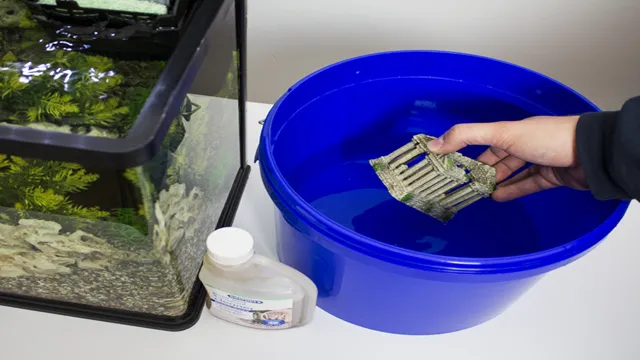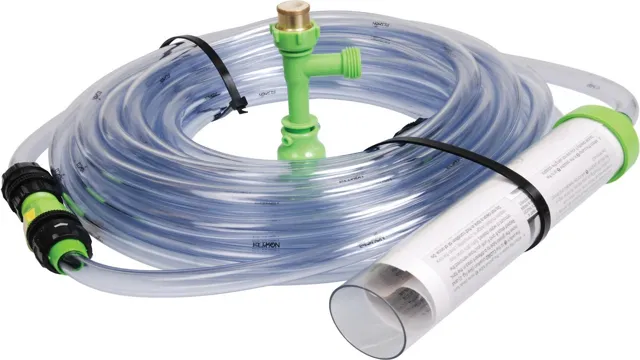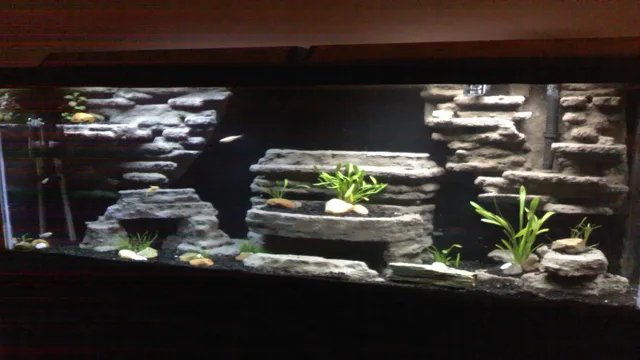How to Make a DIY Aquarium Background: Tips and Tricks for Beautiful Aquariums.
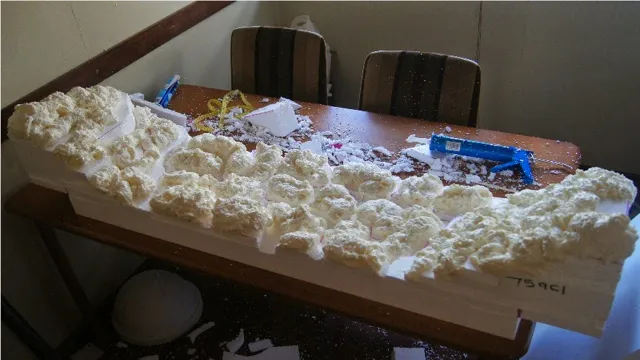
Have you ever wanted to give your aquarium a unique and personalized touch? Adding a DIY aquarium background may be just the thing to make your fish tank stand out. Not only does it add aesthetic value, but it also provides a natural habitat for your aquatic pets. In this step-by-step guide, we’ll show you how to create your own aquarium background that looks professional and fits your personal style.
So, roll up your sleeves and let’s dive in!
Materials Needed
If you’re looking to make a DIY aquarium background, there are some materials that you’ll need to get started. First and foremost, you’ll need styrofoam sheets or blocks to create the base of your background. You’ll also need aquarium-safe silicone sealant to attach the styrofoam pieces together and to the back of your tank.
You’ll want to use a silicone sealant that doesn’t contain any harmful chemicals or additives that could harm your fish. Additionally, you may want to use black or colored aquarium-safe paint to give your background a more natural, polished look. You can also add decorations like rocks, plants, or driftwood to complete the look.
Keep in mind that when creating your background, you want to make sure that it’s sturdy and won’t crumble or fall apart over time. With the right materials and a bit of creativity, you can create a beautiful and unique aquarium background that your fish will love.
Example materials and quantities needed
When it comes to DIY projects, it’s essential to have the right materials to ensure that everything goes smoothly. Depending on the project at hand, materials can vary significantly, but there are some basic materials needed for almost every project. These include things like measuring tape, saws, screwdrivers, hammers, nails, and wood glue.
For larger projects, you may also need materials such as lumber, drywall, and insulation. It’s essential to have enough of each material, so you don’t run out midway through your project. The quantity of materials needed depends on the project’s size, so it’s crucial to have a good idea of how much you will need beforehand.
Proper planning ensures that you don’t waste any money or time on the project. When you have all the necessary materials, your DIY project will be a success, and you’ll be proud of the finished product.
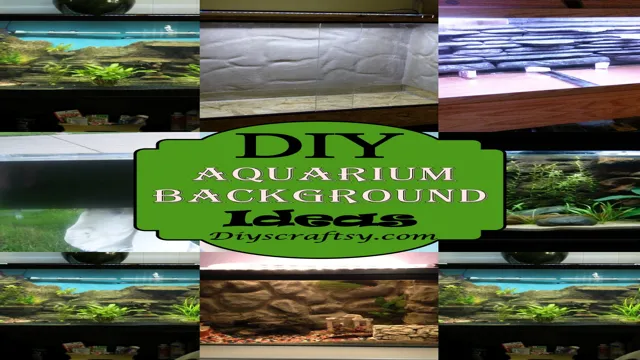
Planning Your Background
Planning your diy aquarium background can seem overwhelming at first, but with the right steps, it can be a fun and rewarding project. Start by deciding on a theme or style you want your aquarium to have. Once you have an idea in mind, create a sketch of your design to help visualize the placement of rocks, plants, and decorations.
Next, gather your materials, such as foam insulation board, a hot wire cutter, and aquarium-safe silicone. Then, use the hot wire cutter to shape the foam insulation board to fit the size and shape of your aquarium. Once the foam is shaped, the fun part begins: using silicone to attach your rocks, plants, and decorations to the background.
Remember to let the silicone cure for 24-48 hours before placing it in your aquarium to avoid any chemical leaching. By taking the time to plan your background and using the right materials, you can create a beautiful and unique diy aquarium background that your fish will love.
Choosing a theme and design
When choosing a theme and design for your blog, one of the most important things to consider is the background. A background can make or break the overall look and feel of your blog, so it’s essential to plan it accordingly. The first thing to decide is whether you want a plain background or a more complex design.
Plain backgrounds can be sleek and modern, but they can also be a bit boring. On the other hand, a more complex background can add character and visual interest, but it could also be overwhelming if not executed properly. Once you have decided on the style of your background, you can think about colors and patterns that will complement your content and overall branding.
It’s crucial to keep in mind that the background should never detract from your content. Instead, it should enhance it and make it more enjoyable for your readers to consume. So, take your time to plan out your blog’s background and ensure that it aligns with your blog’s theme and purpose.
Sketching out a plan
When it comes to planning your background for a sketch, there are a few things to consider. First, think about the setting; is it indoors or outdoors, what time of day, and what kind of environment? This will help you decide on the overall mood and color palette for your background. Next, consider the level of detail you want to include – do you want a simple backdrop or a more intricate landscape? This will also affect the time and effort required for your sketch.
Finally, think about any objects or elements that will be in the foreground and how they will interact with the background. By taking all of these factors into account, you can create a solid plan for your background that will enhance the overall impact of your sketch. So, what kind of backdrop will bring your sketch to life?
Creating the Structure
Looking to create a beautiful and unique aquarium background? With a little bit of DIY know-how, you can easily make an eye-catching background for your tank. The first step is to create the structure of your background. This can be done by using a foam board or styrofoam sheet cut to the size of your aquarium.
Once you have your foam board, you can start adding texture and detail to it using a hot glue gun, aquarium-safe silicone, and a variety of natural materials such as rocks, driftwood, and sand. Make sure to create a few different layers of texture to add depth and interest to your background. Don’t be afraid to experiment and get creative with the materials you use to decorate your background.
The final step is to attach your background to your aquarium using silicone adhesive, and voila! Your very own DIY aquarium background is complete.
Cutting and shaping foam insulation board
Foam insulation board is a popular choice for creating a sturdy structure in DIY projects, especially for insulation boards that provide thermal protection. Cutting and shaping foam insulation board is an essential step in the process of creating a structure. It’s easy to work with, and you don’t need any special equipment.
You can use a variety of tools, including a utility knife or a saw, to cut through the foam insulation board. However, it’s important to wear protective gear, such as gloves and goggles, to prevent any accidents. Additionally, you can shape the foam insulation board using sandpaper or a rasp to give it a smoother, more polished finish.
With a little bit of patience and a steady hand, you can easily create a fully functional structure that will stand the test of time.
Gluing pieces together to form a 3D shape
When it comes to creating 3D shapes, gluing all the pieces together is the ultimate step in finishing the structure. This is where all the hard work pays off and the real magic happens! Using a strong adhesive, carefully line up each piece and secure them in place to form a solid and sturdy shape. Depending on the type of material used, it’s crucial to choose the right glue that will bind the pieces together without causing any warping or damage.
While it may seem like a simple process, gluing can be a bit tricky and require some patience and attention to detail. But once you’ve successfully glued all the pieces together, you’ll have a beautiful and unique 3D structure that’s ready to be admired by all.
Making hidey holes and caves for fish
When it comes to creating a hidey hole or cave for your fish, the structure is key. You want to provide a space that is secure and stable, but also allows your fish to easily come and go as they please. One option is to use natural materials such as rocks, wood, or PVC pipes to create a cave-like structure.
Make sure to thoroughly rinse any materials before adding them to your tank to avoid contamination. You can also purchase pre-made structures specifically designed for aquariums. These often come in various shapes and sizes, and can add a fun and interesting element to your tank.
Whatever option you choose, make sure to place the structure in an area where your fish will feel comfortable and safe, but also has enough space for them to swim around. By providing your fish with a fun and appealing hideaway, you can create a more dynamic and engaging environment for them to thrive in.
Coating the Background
If you’re looking to make a DIY aquarium background, coating it can really help bring it to life. First off, you’ll need to pick the right coating for your background material. If you’re using foam, spray paints and epoxies can be perfect choices.
If you’re using cement or rock, you might want to consider using a concrete sealer or waterproofing paint. Always make sure to research the specific materials you’re using before adding any coatings to avoid damaging your aquarium in the long run. Once your coating is selected, it’s important to prep your background for application.
This may include sanding it down, cleaning it thoroughly, and possibly using a primer or base coat. When applying the coating, be sure to do so in a well-ventilated area and follow all manufacturer instructions. With a little bit of patience, your DIY aquarium background will come to life with a stunning, vibrant coating that your fish and other aquatic creatures are sure to love!
Preparing and applying a suitable sealant
To ensure that your background is properly protected from the elements, you’ll want to apply a suitable sealant. This not only helps to keep the background looking great, but also extends its lifespan by preventing damage from things like moisture and UV radiation. When selecting a sealant, it’s important to choose one that is appropriate for the type of background material you’re working with.
For example, wood may require a different type of sealant than brick or concrete. Once you’ve selected your sealant, the next step is to apply it evenly to the surface of the background. This can often be done using a brush or roller, but be sure to follow the manufacturer’s instructions for best results.
With regular reapplication as recommended, your background will stay looking its best for years to come.
Using paint or aquatic-safe sealant to add texture and details
When it comes to creating a visually stunning aquarium, adding texture and details to the background can make a huge difference. One way to achieve this is by using paint or aquatic-safe sealant to coat the background. Not only does this add texture, but it also enhances the overall aesthetic of the aquarium.
It’s important to note that any paint or sealant used should be specifically designed for aquariums, as some types can be harmful to the aquatic life inside. Before starting, make sure to thoroughly clean and dry the background surface to ensure proper adhesion. With a steady hand, apply the paint or sealant in the desired texture or design, and allow it to fully dry before adding any plants or fish.
With this simple step, you can take your aquarium from bland to beautiful in no time!
Installing Your DIY Background
If you’re looking to add some personality to your aquarium and want to create a DIY background, you’ve come to the right place. With just a few supplies, you can make a unique and eye-catching background that will make your aquarium stand out. First, you’ll need a foam board cut to the size of your tank.
Next, use a hot glue gun to attach pieces of lava rocks or slate to the foam board, creating the desired texture and depth. You can also paint the background with non-toxic paint to add a pop of color or create a natural-looking scene. Once you’ve finished decorating the background, simply slide it into the back of your aquarium, securing it with aquarium safe silicone.
In no time, you’ll have a beautiful and personalized aquarium background that you can be proud of. Happy crafting!
Cleaning and preparing your aquarium
Installing a DIY background in your aquarium may seem like a daunting task, but it’s actually quite simple and can add a beautiful touch to your tank. Before you install your background, make sure to thoroughly clean and prepare your aquarium. This involves removing any old decorations or substrate, cleaning the glass and adding fresh water.
Once your tank is ready, it’s time to install the background. Start by measuring the dimensions of your aquarium and cutting the background material to size, making sure to leave a little extra for overlap. Next, apply a thin layer of aquarium silicone to the back of the tank and carefully press the background material into place.
Smooth out any air bubbles and allow the silicone to dry completely before adding any water or fish. By following these steps, you can create a stunning aquarium with a custom DIY background that will impress all of your visitors.
Securing the background in place
When it comes to installing your DIY background, securing it in place is an essential step to ensure that your photoshoot runs smoothly. One way to do this is by using clamps to hold the background against a flat surface. This will prevent any accidental movements that may alter the positioning of the background during the shoot.
Another option is to use adhesive tape, especially if you’re working with a smaller background. Ensure that the tape is strong enough to hold the weight of the background and doesn’t leave any residue on it. You can also use a support system, such as a stand, for larger backgrounds.
Make sure to tighten all joints and clamps to prevent any instability. By taking these steps, you can be sure that your background will stay in place throughout the photoshoot, allowing you to focus on capturing the perfect shot.
Maintenance and Care
If you’re looking to make a DIY aquarium background, the process is actually quite simple! First, gather all the materials you’ll need – which includes foam insulation board, a knife or saw, silicone sealant, and aquarium-safe acrylic paint. Next, measure the dimensions of your aquarium and cut the foam insulation board to fit accordingly. Then, use the knife or saw to carve out the design you desire – such as rocks, caves, or plants – into the foam.
Once you’re happy with the design, apply the silicone sealant to the back of the foam and attach it to the back of the aquarium. Allow the sealant to dry completely, then apply the aquarium-safe acrylic paint to the foam to complete your custom aquarium background! Remember to allow the paint to dry completely before filling the tank with water. With a little patience and creativity, you can have a unique and personalized aquarium background that your fish will love!
Cleaning the background
When it comes to maintaining and caring for your home, cleaning the background is often overlooked but is just as important as cleaning the surfaces of your home. A dirty or cluttered background can detract from the overall look and feel of your space, making it feel uninviting and chaotic. To keep your background clean, start by decluttering any excess items that are taking up space.
This will not only make your background look cleaner but also make it easier to clean in the future. Once you’ve decluttered, use a damp cloth to wipe down any surfaces, paying special attention to corners and nooks where dust can accumulate. If you have wallpaper or painted walls, consider using a gentle cleaner to remove any stains or marks.
Finally, don’t forget to vacuum or sweep the ground to remove any debris or dirt. By taking the time to clean your background regularly, you’ll be able to enjoy a clean and inviting space that feels comfortable and welcoming.
Monitoring and adjusting water parameters as needed
One of the most important aspects of maintaining a healthy aquarium is monitoring and adjusting water parameters as needed. This includes testing the pH, ammonia, nitrite, and nitrate levels, as well as ensuring proper water hardness and alkalinity. Monitoring water parameters is crucial because they can fluctuate over time due to fish waste, uneaten food, and other factors.
If levels become too high or too low, it can lead to health problems for your fish and other aquatic creatures. Therefore, it’s important to regularly test the water and adjust the parameters as needed using appropriate treatments and additives. By staying on top of water quality, you can help ensure a healthy and thriving aquarium for your aquatic pets.
Conclusion and Final Tips
In conclusion, making a DIY aquarium background can be a fun and rewarding project for any fish enthusiast. Not only does it provide a unique and personalized touch to your aquarium, but it also allows you to exercise your creativity and showcase your artistic skills. So go ahead, dive into the world of DIY aquarium backgrounds, and create a stunning underwater masterpiece that both you and your fish will love!”
Showcasing and enjoying your new aquarium feature
When it comes to aquariums, maintenance and care are crucial for the health and longevity of your aquatic pets. Regular water changes, proper filter maintenance, and regulating the temperature are just some of the necessary tasks to ensure a thriving environment. However, maintenance doesn’t have to feel like just another chore.
It can be a time to appreciate the beauty of your aquarium and take pride in the hard work you put into its upkeep. Think of it like tending to a garden; sure, it requires effort, but it’s also a rewarding experience. Take the opportunity to observe your fish, plants, and decorations up close.
Notice any changes or growth and take joy in the progress. By embracing the maintenance process and making it a part of your routine, you’ll not only have a healthy aquarium but also a source of joy and relaxation in your home. So roll up your sleeves, grab your fishnet, and get ready to showcase and enjoy your aquarium feature!
Ongoing experimentation and customization
When it comes to maintaining and caring for a website, ongoing experimentation and customization is key to ensuring it remains responsive and user-friendly. It’s important to continually monitor and test various components of your website, such as its speed, navigation, and functionality. Doing so will help identify any issues or potential areas for improvement, allowing you to tailor your website to better meet the needs and preferences of your users.
Additionally, regular updates and maintenance can help prevent security breaches and ensure your website remains optimized for search engines. By prioritizing ongoing experimentation and customization, you can continue to enhance and optimize your website, offering a seamless and enjoyable user experience to your visitors.
FAQs
What materials do I need for making a DIY aquarium background?
For making a DIY aquarium background, you will require foam board or Styrofoam, aquarium-safe silicone, acrylic paint, sand, rocks, and plastic plants.
What tools are necessary to make a DIY aquarium background?
You will need a hot glue gun or a silicone gun, a foam cutter, a craft knife, and a paintbrush to make a DIY aquarium background.
How do I cut foam board or Styrofoam for making a DIY aquarium background?
You can use a foam cutter or a sharp knife to cut the foam board or Styrofoam according to the desired size and shape. Make sure to wear protective gloves and eyewear during cutting.
What are the steps to make a DIY aquarium background?
Firstly, sketch the design on a foam board or Styrofoam using a pencil. Cut the foam board or Styrofoam according to the sketch with a foam cutter or knife. Glue the pieces with aquarium-safe silicone and let them dry. Paint the background with acrylic paint and let it dry. Finally, cover the cracks with sand, rocks, and plastic plants to complete the look.
Is DIY aquarium background safe for aquatic creatures?
Yes, DIY aquarium backgrounds made with aquarium-safe silicone and paints are safe for aquatic creatures and plants.
Can I customize the DIY aquarium backgrounds according to my aquarium size and theme?
Yes, you can customize the DIY aquarium background shapes, colors, and textures according to your aquarium size and theme.
Are DIY aquarium backgrounds cost-effective as compared to the store-bought ones?
Yes, making a DIY aquarium background is cost-effective as compared to buying a store-bought one as you can get the materials at a reasonable price and customize it according to your preference.

